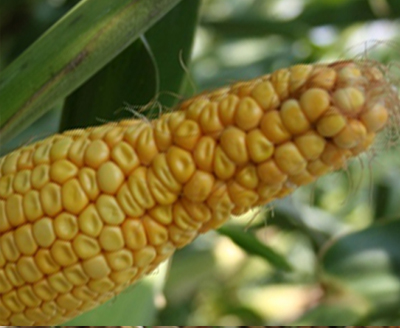
- Ear malformations can be caused by many factors.
- Off label pesticide applications, temperature and moisture stress, diseases and insects and nutrient imbalances can all result in ear malformations.
- Diagnosing the potential causes can help us better understand what could have gone wrong and, if under our control, make adjustments accordingly.
Pinched or “beer bottle” ears are ear malformations attributed to late applications of ALS-inhibiting herbicides after the V6 growth stage. Non-GMO corn growers may commonly use ALS inhibitors, such as Accent® Q, postemergence to control annual grasses. When applied late, ALS herbicides accumulate in the actively growing whorl, causing the whorl to restrict the girth of the ear going forward, resembling the shape of a beer bottle (Fig. 1). The risk of pinched ears can be minimized by scouting early and making those applications before corn reaches V6.
Blunt ear syndrome (BES) is another ear malformation that has been researched for decades and no real cause has been determined yet. With BES the kernel rows around will not be affected, but the kernel row length will be halted making the ear look like a soda or beer can in size. Initially some postemergence corn herbicides were thought to be the culprit of BES. Later on, a cold period around the V8 growth stage near the ear formation stage, was thought to be a factor contributing to BES.
Moisture stress, too much or too little, can affect corn development and reduce yields. Drought can severely impact crop yields. Considering that the potential number of kernel rows is typically determined around the V7 growth stage, drought stress around the V5-V7 growth stage can greatly impact kernel row number. Additionally drought during pollination will result in reduced pollination and abortion of kernels. Corn that has been severely affected by drought will often have smaller, nubbin type ears; sometimes there will even be sporadic areas on the cob and tips with no kernels, due to the lack of pollination (Fig. 2)
Arrested ear syndrome is typically caused by mid to late vegetative applications of fungicides with an adjuvant. Non-ionic surfactants (NIS) are commonly applied with fungicides at and after VT, to improve fungicide coverage and uptake into the leaf. However, when sprayed prior to VT, these adjuvants can arrest ear development. That’s why corn fungicide labels will advise against using adjuvants between V8-VT. Fungicides alone, without an adjuvant, applied during these vegetative stages will not result in crop injury. Determination of the ear length and number of kernels per row, is usually complete by V12-V15. This process is highly influenced by the environment and certain stressors can interfere with ear length development. Research from Purdue University found that adjuvants such as NIS or crop oil concentrates, when applied around V14, may contribute to the development of arrested ears. Although there are a few hypotheses related to the mechanisms by which adjuvant use, prior to VT, can result in arrested ears, no clear-cut explanation is available.
Another ear malformation that can be found at harvest time is tip dieback. High temperatures, foliar diseases, cloudy weather, nitrogen and other nutrient deficiencies, drought and high planting populations can all contribute to tip dieback. Ears with tip dieback look like unfilled ear tips or little to very minimal kernel development on the tip 1-3 inches of the cob. The “dried and shrunken” kernels are typically due to a lack of ovule fertilization and can become a light yellow to white color or even a brownish color. Tip dieback can be managed to an extent by providing adequate soil fertility, minimizing crop stress as much as possible and selecting hybrids appropriate for your soil type and growing conditions. Yield may not always be limited in the case of tip dieback, as some ears may contain a greater number of kernels around than a normal ear, to compensate for the tipback.
Not all of these malformations can be prevented; environmental factors cannot be controlled, except for drought when irrigation is an option. Foliar disease however can be mitigated with the use of fungicides, and compaction can be prevented by staying off of wet soils. Lastly, once the damage is done, we often cannot fix the problem, but we certainly can learn from the issue to help prevent it in years to come. We wish everyone a safe and smooth harvest.
Figure 1: Pinched or Beer Bottle Ear
Figure 2: Drought affected ear
